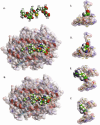Functional inhibition related to structure of a highly potent insulin-specific CD8 T cell clone using altered peptide ligands
- PMID: 18157812
- PMCID: PMC2901522
- DOI: 10.1002/eji.200737762
Functional inhibition related to structure of a highly potent insulin-specific CD8 T cell clone using altered peptide ligands
Abstract
Insulin-reactive CD8 T cells are amongst the earliest islet-infiltrating CD8 T cells in NOD mice. Cloned insulin B15-23-reactive cells (designated G9C8), restricted by H-2K(d), are highly diabetogenic. We used altered peptide ligands (APL) substituted at TCR contact sites, positions (p)6 and 8, to investigate G9C8 T cell function and correlated this with structure. Cytotoxicity and IFN-gamma production assays revealed that p6G and p8R could not be replaced by any naturally occurring amino acid without abrogating recognition and functional response by the G9C8 clone. When tested for antagonist activity with APL differing from the native peptide at either of these positions, the peptide variants, G6H and R8L showed the capacity to reduce the agonist response to the native peptide. The antagonist activity in cytotoxicity and IFN-gamma production assays can be correlated with conformational changes induced by different structures of the MHC-peptide complexes, shown by molecular modeling. We conclude that p6 and p8 of the insulin B15-23 peptide are very important for TCR stimulation of this clone and no substitutions are tolerated at these positions in the peptide. This is important in considering the therapeutic use of peptides as APL that encompass both CD4 and CD8 epitopes of insulin.
Figures





Similar articles
-
Identification of an MHC class I-restricted autoantigen in type 1 diabetes by screening an organ-specific cDNA library.Nat Med. 1999 Sep;5(9):1026-31. doi: 10.1038/12465. Nat Med. 1999. PMID: 10470079
-
Persistence, immune specificity, and functional ability of murine mutant ras epitope-specific CD4(+) and CD8(+) T lymphocytes following in vivo adoptive transfer.Cell Immunol. 1999 May 25;194(1):78-89. doi: 10.1006/cimm.1999.1489. Cell Immunol. 1999. PMID: 10357883
-
TLR9 blockade inhibits activation of diabetogenic CD8+ T cells and delays autoimmune diabetes.J Immunol. 2010 May 15;184(10):5645-53. doi: 10.4049/jimmunol.0901814. Epub 2010 Apr 14. J Immunol. 2010. PMID: 20393135
-
Epitope specificity, cytokine production profile and diabetogenic activity of insulin-specific T cell clones isolated from NOD mice.Eur J Immunol. 1995 Apr;25(4):1056-62. doi: 10.1002/eji.1830250430. Eur J Immunol. 1995. PMID: 7537670
-
Hybrid insulin peptides are neo-epitopes for CD4 T cells in autoimmune diabetes.Curr Opin Endocrinol Diabetes Obes. 2019 Aug;26(4):195-200. doi: 10.1097/MED.0000000000000490. Curr Opin Endocrinol Diabetes Obes. 2019. PMID: 31166225 Free PMC article. Review.
Cited by
-
Efficient Presentation of Multiple Endogenous Epitopes to Both CD4+ and CD8+ Diabetogenic T Cells for Tolerance.Mol Ther Methods Clin Dev. 2016 Dec 24;4:27-38. doi: 10.1016/j.omtm.2016.12.002. eCollection 2017 Mar 17. Mol Ther Methods Clin Dev. 2016. PMID: 28344989 Free PMC article.
-
A Single L/D-Substitution at Q4 of the mInsA2-10 Epitope Prevents Type 1 Diabetes in Humanized NOD Mice.Front Immunol. 2021 Aug 30;12:713276. doi: 10.3389/fimmu.2021.713276. eCollection 2021. Front Immunol. 2021. PMID: 34526989 Free PMC article.
-
Advances in cellular therapy for the treatment of thyroid cancer.J Oncol. 2010;2010:179491. doi: 10.1155/2010/179491. Epub 2010 Jun 29. J Oncol. 2010. PMID: 20671939 Free PMC article.
-
Distortion of the Major Histocompatibility Complex Class I Binding Groove to Accommodate an Insulin-derived 10-Mer Peptide.J Biol Chem. 2015 Jul 31;290(31):18924-33. doi: 10.1074/jbc.M114.622522. Epub 2015 Jun 17. J Biol Chem. 2015. PMID: 26085090 Free PMC article.
-
An altered CD8+ T cell epitope of insulin prevents type 1 diabetes in humanized NOD mice.Cell Mol Immunol. 2019 Jun;16(6):590-601. doi: 10.1038/s41423-018-0058-3. Epub 2018 Jun 28. Cell Mol Immunol. 2019. PMID: 29955175 Free PMC article.
References
-
- Evavold BD, Sloan-Lancaster J, Allen PM. Tickling the TCR: selective T-cell functions stimulated by altered peptide ligands. Immunol. Today. 1993;14:602–609. - PubMed
-
- Sloan-Lancaster J, Allen PM. Altered peptide ligand-induced partial T cell activation: molecular mechanisms and role in T cell biology. Annu. Rev. Immunol. 1996;14:1–27. - PubMed
-
- Kalergis AM, Nathenson SG. Altered peptide ligand-mediated TCR antagonism can be modulated by a change in a single amino acid residue within the CDR3 beta of an MHC class I-restricted TCR. J. Immunol. 2000;165:280–285. - PubMed
-
- Ford ML, Evavold BD. An MHC anchor-substituted analog of myelin oligodendrocyte glycoprotein 35–55 induces IFN-gamma and autoantibodies in the absence of experimental autoimmune encephalomyelitis and optic neuritis. Eur. J. Immunol. 2004;34:388–397. - PubMed
-
- Ryan KR, McNeil LK, Dao C, Jensen PE, Evavold BD. Modification of peptide interaction with MHC creates TCR partial agonists. Cell. Immunol. 2004;227:70–78. - PubMed
Publication types
MeSH terms
Substances
LinkOut - more resources
Full Text Sources
Medical
Research Materials

